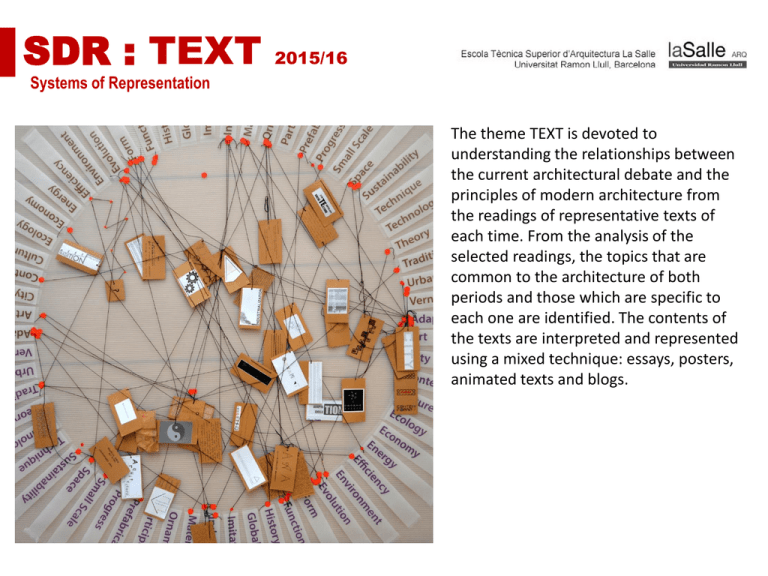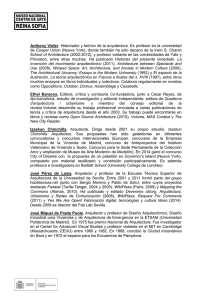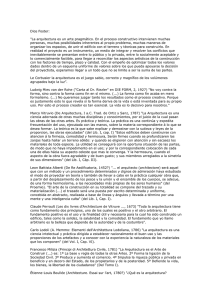Systems of Representation - ARC Enginyeria i Arquitectura La Salle
Anuncio

SDR : TEXT 2015/16 Systems of Representation The theme TEXT is devoted to understanding the relationships between the current architectural debate and the principles of modern architecture from the readings of representative texts of each time. From the analysis of the selected readings, the topics that are common to the architecture of both periods and those which are specific to each one are identified. The contents of the texts are interpreted and represented using a mixed technique: essays, posters, animated texts and blogs. SECUENCIA Activities sequences DE ACTIVIDADES: REFLEXIONES Interpreting, representing and communicating Contemporary architecture Modern architecture Relating periods Animation typography Creating a blog 1 2 3 4 5 Describing a topic. Relating three concepts. And designing a Expressive typography Describing a topic. Relating three concepts. And designing a Expressive typography Relating two periods through concepts. Designing an animated writing to express the evolution of concepts between the two periods by: moving text, animated text, storyboard. Creating an animated sequence to explain the evolution of concepts from modern to contemporary architecture Summarizing the ideas developed in the previous tasks in a blog. Reflecting 1 2 Commenting References Commenting the works Relating the ideas discussed submitted by other peers by the whole class in in SDR:NET previous assignments to architectural works. 3 Communicating Relating different items from SDR:NET (concept descriptions, exercises, references, … ) to build a post for the blog. Interpreting, representing and communicating OBJECTE-FORMA Contemporary architecture Modern architecture Relating periods Motion typography Creating a blog Description The task consists of reading one article about contemporary architecture to synthesize the ideas contained in the text in three ways: 1. Writing a short text (maximum 300 words) summarizing –with your own words– some of the main ideas discussed in the article. 2. Selecting three concepts in a vocabulary that match the topics discussed in the article. 3. Representing the main theme of the article using the techniques of expressive typography. Objectives The first objective of this task is to become acquainted with the current debate about contemporary architecture, as expressed in articles published in architectural journals. The purpose is to reflect about some key issues which today’s architecture is concerned with such as sustainability, participation, technology, urban development, construction and industrialization. The second objective is to synthesize and communicate the content of the articles in different media: with words and with typographic design. Selected readings 1. Ramón Araujo. On Architecture and Industry; 2. Jesús San Vicente. The Future of Non-Pedigreed Architecture; 3. Santiago de Molina. The Small: a Philosophy for Architects; 4. Francisco de Gracia. The Dilemma of ‘Building on the Built’, and 5. Los Certificadores. Energetic Rapanui Pronouncement. Interpreting, representing and communicating: Contemporary architecture Guillaume Bernard Interpreting, representing and communicating: Contemporary architecture Alan Ferrando Shearer Interpreting, representing and communicating: Contemporary architecture Lluis Pozo Massó Interpreting, representing and communicating OBJECTE-FORMA Contemporary architecture Modern architecture Relating periods Motion typography Creating a blog Description The task consists of reading one manifesto about modern architecture to synthesize the ideas contained in the text in three ways: 1. Writing a short text (maximum 300 words) summarizing –with your own words– some of the main ideas discussed in the manifesto. 2. Selecting three concepts in a vocabulary that match the topics discussed in the manifesto. 3. Representing the main theme of the manifesto using the techniques of expressive typography. Objectives The first objective of this task is understand some of the principles of modern architecture as expressed in the selected manifestoes. The purpose is to reflect about the ideas contained in the article from the point of view of contemporary architecture. For example: is the discussion about ornament still applicable to today architecture, and in which ways? Has the meaning of function changed? Is the relation between architecture and technique the same today as it was for modern architecture? Does the architecture of our time reflect the characteristics of our time? The second objective of this activity is to synthesize and communicate the content of the manifestos in different media: with words and with typographic design. Selected readings 1. Le Corbusier. Towards a new architecture: guiding principles; 2. Mies Van der Rohe. Working theses; 3. Adolf Loos. Architecture; 4. Antonio Sant Elia, Filippo Tommaso Marinetti. Futurist architecture and 5. Theo Van Doesburg. Towards a plastic architecture. Interpreting, representing and communicating: Modern architecture Hugo Jimenez Sanchez Interpreting, representing and communicating: Modern architecture Ana Ubach De Ignacio Simó Interpreting, representing and communicating: Modern architecture Lluis Pozo Massó Interpreting, representing and communicating: Modern architecture Juan José Abarca Puyalto Interpreting, representing and communicating OBJECTE-FORMA Contemporary architecture Modern architecture Relating periods Motion typography Creating a blog Description The purpose of this activity is to find relationships between some of the ideas contained in the manifestos of modern architecture and the ideas derived from the reading of the articles about contemporary architecture previously carried out in the first activity. Objectives The first objective of this activity is to establish links between the program of modern architecture and the issues that concern contemporary architecture, by identifying continuities and discontinuities between the ideas discussed in both periods: What issues are common to both? What topics are unique to contemporary architecture? Which are the different meanings given to the same concepts (technique, form, …) in each period?, and so on. The second objective is to synthesize and communicate the relation (or relations) identified between the two periods using the techniques of expressive typography. Interpreting, representing and communicating: Relating periods Ana Ubach De Ignacio Simó Interpreting, representing and communicating: Relating periods Lluis Pozo Massó Interpreting, representing and communicating: Relating periods Juan José Abarca Puyalto Interpreting, representing and communicating: Relating periods Clara Viader Nogués Interpreting, representing and communicating OBJECTE-FORMA Contemporary architecture Modern architecture Relating periods Motion typography Creating a blog Description To give visual expression to the theme proposed in the previous task “Relating periods” using the resources of motion typography. Objectives To communicate the ideas proposed in the activity “Relating periods” –though the text in the expressive typography– by means of an animated typography. The purpose is to use the temporal dimension to continue developing and communicating ideas about the relationships between the two periods: modern and contemporary architecture. Interpreting, representing and communicating: Motion typography Jordi Barceló Solé INDUSTRIALIZACIÓN Es nuestra obligación, de los arquitectos e ingenieros, utilizar los sistemas industriales y las nuevas tecnologías evolucionando la arquitectura para cumplir las nuevas demandas actuales. Conseguir unos edificios más económico y eficientes ahorrando recursos y tiempo, creando edificios prefabricados modulares rápidos de construir y modificar. Crear una arquitectura que empiece en una fábrica de montaje en serie, aumentando la productividad, la eficiencia de los trabajadores, consiguiendo una mejor optimización de materiales y tiempo… no hablo solo de las materias primas de construcción, si no, de edificios modulares que se monten como puzles en cuestión de horas y que cumplan con todas las expectativas que un edificio debe cumplir. Que los edificios tengan su forma y diseño dada por sus funciones y sus procesos de fabricación, no por una cuestión meramente estética y recargada de decoraciones no esenciales. Interpreting, representing and communicating: Motion typography Hugo Jimenez Sanchez FUNCIONAL La ornamentación es un tema recurrente en la arquitectura, bien por su uso excesivo o por su aparente inexistencia. Los precursores de la arquitectura Moderna, hartos de la sobresaturación, “rompieron” con la tradición de su época eliminando la recargada ornamentación clásica y cualquier elemento accesorio sin funcionalidad. Simplificando las formas y los volúmenes a la mínima expresión. La Arquitectura Contemporánea suavizó la rigidez de sus predecesores incorporando elementos decorativos usando los avances tecnológicos y los nuevos materiales, pero tratando de resolver los problemas sociales e intentando dar soluciones en el ámbito urbano. El ornamento deja de ser un mero elemento decorativo y pasa a ser un instrumento que permite acercar la arquitectura al usuario, es difícil establecer si lo ornamental es siempre funcional pero es labor de los arquitectos integrar el ornamento de una manera funcional. Interpreting, representing and communicating: Motion typography Meritxell Padullés Solé Industrialization is behind evolution. Evolution and industrialization work together during the different periods oh architecture; contemporary and modern architecture. Industrialization advances influencing architecture and causing its evolution. In order to reflect this I have done a flash, which as you move the cursor in the screen which has the shape of the word “EVOLUTION”; the word “INDUSTRIALIZATION” appears continuously behind it. With this I am trying to reflect the way in which industrialization forms evolution. Interpreting, representing and communicating: Motion typography Lluis Pozo Massó Architektura La arquitectura que busca un fin ornamental se ha dejado atrás. Ahora se busca una arquitectura para el usuario, cuyo primordial objetivo es el de servirle. Este sencillo motion graphic tiene como objetivo mostrar con más claridad el paso de una arquitectura ornamental, en la que se enfatiza la forma y color sin tener ningún valor añadido, a una arquitectura cuya primordial preocupación es el de servir al usuario. Para conseguirlo se ha de emfatizar el estudio del interior, que es donde se habita. En cambio el exterior tiene cómo única función el de abastecer y proteger al interior. Podríamos decir que la forma del exterior la da el interior, de la misma manera que interior y exterior están estrechamente unidos. Uno no se entiende sin el otro. Paralelamente, tal como describe Adolf Loos en, ornamento y delito, la nueva arquitectura, la que rechaza una ornamentación vanal, no olvida el pasado, y se entiende este cambio conceptual como una evolución de la história, pues si se ha llegado a esta nueva concluisón es porque ha existido el pasado, del que nos hemos aprovechado. Interpreting, representing and communicating OBJECTE-FORMA Contemporary architecture Modern architecture Relating periods Motion typography Creating a blog Description Creating a post in the collective blog of the class (http://www.arqpress.blogspot.com.es/) summarizing some of the ideas -developed by the student and by the whole class concerning the relationships between the contemporary architectural debate and the architectural program of modern architecture. Objectives To assess the ideas developed by the class through the different tasks carried out so far which are available in the learning environment SDR : NET. To identify some of those ideas – expressed in texts and graphics– and to communicate them through the blog. Interpreting, representing and communicating: Creating a blog Jordi Barceló Solé Interpreting, representing and communicating: Creating a blog Clara Viader Nogués Interpreting, representing and communicating: Creating a blog Guillaume Bernard Interpreting, representing and communicating: Creating a blog Lluis Pozo Massó Reflecting OBJECTE-FORMA References Description The purpose of this activity is to illustrate the ideas contained in the exercise “Motion typography” with some examples of contemporary architecture. Objectives To establish links between some of the ideas explored in the exercise “Motion typography” (for example, the evolution of ornament from modern to contemporary architecture) and some of the ideas, projects or buildings produced by today’s architects (for example, a building that illustrates an idea of ornament prevalent today; a competition project or a building which express a contemporary view of this concept). The activity will be done twice: one related to the student’s own work, and a second one for the work of another student. In both cases, the objective is to provide a reference to the ideas discussed in the exercise “Motion typography”. Reflecting : References Industrialización | Jordi Barceló Solé Buscando ejemplos de edificios prefabricados y modulares siguiendo en la línea de la influencia de la industrialización en el mundo de la arquitectura, me he topado con los edificios construidos con contenedores reciclados. Este sistema de construcción, además de usar elementos modulares prefabricados, también reutiliza elementos provenientes de la industria como son los contenedores de transporte. De esta forma, estos edificios crean un matrimonio entre industria y sostenibilidad, dos conceptos que muchos creen que son incompatibles. LINK: http://www.iniciativamexico.org/blog/un-edificio-hecho-de-contenedores/ Ornamento Multifuncional | Hugo Jimenez Sanchez El museo Guggenheim diseñado por el arquitecto Frank Gehry, nace cómo un elemento ornamental para mejorar la estética de una ciudad poco agraciada, con una apariencia sucia y estancada en el pasado. Ubicado en una zona industrial, totalmente antagónica a su finalidad cultural, ha sido el catalizador de un cambio y regeneración, no sólo de una zona concreta de la ciudad, sino de toda ella. Su función inicial, no parece a priori un motivo suficiente para motivar la transformación del entorno urbano, pero su estética y ornamentaleidad, llaman la atención de tal manera que ha pasado a convertirse en un icono que traspasa las fronteras locales convirtiéndose en un símbolo global y posicionando la ciudad de Bilbao en el panorama internacional. El ornamento multiplica la función, de tal manera que un “simple” museo, pasa a ser el motor del desarrollo urbanístico y económico de la ciudad, al mismo tiempo que una sociedad tradicional se siente identificada con este nuevo símbolo de progreso e innovación. LINK: http://www.guggenheim.org/bilbao Reflecting : References EL FUTURISMO | Juan José Abarca Puyalto Si hoy Marinetti y Sant’Elia vieran la ciudad de Barcelona se dirían a sí mismos que efectivamente en 1914 estaban en lo cierto. El futurismo hoy es un hecho. La tecnología que utilizan las máquinas, los flujos de personas, la vida a gran velocidad y la energía en movimiento hoy forman parte de nuestro día a día de velocidad, tecnología e inmediatez. La roda de Dalt es un gran ejemplo de cómo se han cumplido sus visiones de cómo fabricar la ciudad de su futuro, o mejor dicho, de nuestro presente. En cuanto arquitectura con ideas futuristas, me llama la atención El Hotel Hesperia de Hospitalet de Llobregat, donde los autores Richard Rogers, Luis Alonso y Sergi Balaguer muestran la estructura del edificio, los núcleos de comunicaciones verticales (escaleras y ascensores) y las instalaciones, donde a su vez forman parte de la composición, transformándose en elementos casi escultóricos que confieren singularidad y expresividad al edificio. Desde el interior | Lluis Pozo Massó Esta obra, la casa Salo de Patrick Dillon, a simple vista es un claro ejemplo de arquitectura vernácula y respectiva con el medio que le rodea, pero si nos fijamos más detalladamente vemos como el gran protagonismo lo tiene el diseño del interior. En ella se diseña un espacio de dos niveles, totalmente flexible y diáfano que permite la elaboración de múltiples espacios a merced del usuario: sofás móviles, encimera de cocina que permite comer con comodidad, zona de cocción en interior y exterior, un envolvente formado por tabiques móviles. A su vez, aprovecha el agua pluvial recogida por la cubierta para instalaciones de lavado y refrigeración. Tanto el diseño del interior como el hecho de realizar una cubierta que recoja agua pluvial, son los factores que marcan la forma exterior. LINK: http://http://divisare.com/projects/299524-fernando-alda-www-fernandoalda-com-patrick-dillon-salo-house Reflecting : References Forms and their Functions | Alexandra Hernandez In today’s society, where we are racing to innovate and find better solutions in architecture this building does the job. It’s a great example of the correlation between form and function. As Frida Varegg writes about modern and contemporary architecture, regarding form and function respectively, “With geometrical shapes, possibilities grew. The function of the building became a huge priority.” The building shown in the pictures is the Potash Architects studio located in Tel Aviv. The modern office consist of seven repurposed shipping containers. This is a perfect example of basic shapes giving a space functionality. To quote F. Varegg again “Strict rules of how the characteristics of the building should be, does not longer exist.” Exhibition SDR : TEXT 2015/16 Systems of Representation During the theme TEXT, students built a conceptual wheel showing the relationships between the current architectural debate and the principles of modern architecture. Each student selected two concepts of different periods of time and relate them using a string. This relationship was explained with a card with a textual explanation in one side and a visual representation in the other side. This wheel is a graphical representation of the connections between concepts done on the net. It is, in fact, a physical version of the activity “relating periods”. Exhibition SDR : TEXT Systems of Representation 2015/16 Exhibition SDR : TEXT Systems of Representation 2015/16 Exhibition SDR : TEXT Systems of Representation 2015/16 Exhibition SDR : TEXT Systems of Representation 2015/16 SDR : TEXT 2015/16 Systems of Representation SDR Systems of Representation Prof. Leandro Madrazo, Mario Hernández, Marta Sabat and Franc Bardera School of Architecture La Salle - 2016 More information: [email protected] www.salle.url.edu/sdr

